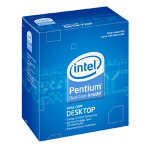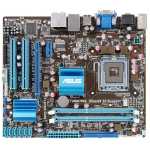System Buyers' Guide: PCs for Under $1000
by Sean Hollister on February 12, 2010 2:00 AM EST- Posted in
- Guides
Intel Entry-Level PC
From Pentium 4 to Pentium D, Core 2 Duo to Core 2 Extreme—not to mention the occasional Celeron and Xeon—Intel's LGA 775 socket has had a long, illustrious six years housing powerful processors. We're not going to write LGA 775's obituary quite yet, as Intel hasn't officially announced an end-of-life date for the aging socket. But with widespread availability of a mainstream successor in LGA 1156 and leaked Intel roadmaps depicting only the Pentium Dual-Core chips to continue through 2010, the writing's on the wall. If you buy an LGA 775 system today, don't expect to be able to easily upgrade its processor through retail channels next year.
However, none of that says an LGA 775 processor and motherboard can't be the base for a fantastic budget PC. LGA 775 chips have proven to be excellent overclockers, with many of the recent 45nm SKUs capable of reaching speeds up to 4GHz at stock voltage. They are mature and reliable; multiple AnandTech editors still use them in their home PCs, and clock for clock they continue to compete well against AMD's offerings (albeit at generally higher prices and/or lower core counts). And should you still want to upgrade at some point down the road, the aforementioned wide variety of compatible processors means that you may still find an opportunity to do so in the secondhand market.
| Intel Entry-Level System | ||
| Hardware | Component | Price |
| Processor | Intel Pentium Dual-Core E5300 (2.6GHz x2, 45nm, 2MB L2 Cache) |
$65 |
| Cooling | CPU Retail HSF | $0 |
| Video | Onboard | $0 |
| Motherboard | ASUS P5G43T-M Pro LGA 775 Micro ATX | $80 |
| Memory | G.Skill Ripjaws 4GB DDR3-1600 F3-12800CL9D-4GBRL | $105 |
| Hard Drive | WD Caviar Blue 500GB WD5000AAKS | $54 |
| Optical Drive | Sony Optiarc Model AD-7240S-OB 24X DVDRW SATA | $28 |
| Audio | Onboard | $0 |
| Case | Cooler Master Centurion 5 CAC-T05-UW Mid Tower ATX | $55 |
| Power Supply | OCZ ModXStream Pro 500W ATX12V SLI Certified, CrossFire Ready, 80 PLUS Certified Modular Active PFC (before $25 Rebate) | $65 |
| Base System Total | $452 | |
| Display | ASUS VW193TR Black 19" 5ms Widescreen LCD (1440 x 900) | $120 |
| Speakers | Built-in Monitor | $0 |
| Input | Microsoft B2L-00045 Comfort Curve Black USB Keyboard and Optical USB Mouse - OEM | $22 |
| Operating System | Microsoft Windows 7 Home Premium OEM 1-Pack (for System Builders) | $105 |
| Complete System Total | $699 | |
| Plus Estimated Shipping (within Continental U.S.) | $715 | |
| Rebates | -$25 | |
| Final Total (less tax, if applicable) | $690 | |
 |
Since December 2008, our CPU of choice for the Intel Entry-level PC has been the excellent Pentium Dual-Core E5200 Wolfdale: a 2.5GHz, $64 processor that hit a sweet spot in the price/performance ratio that no other Intel chip could match. Today, we're going to stray ever so slightly from our previous recommendation and suggest you pick up its bigger brother, the 2.6GHz Pentium Dual-Core E5300 instead. Why? Simply put, the $65 E5300 is the exact same chip, but with a 13x multiplier that immediately makes it 100MHz faster—for only $1 more. And considering that 13x multiplier also means a higher maximum overclock than that of the 12.5x E5200, we believe that extra $1 is money very well spent.
It's also important to note that since late 2009, new E5300 processors have been shipping with Intel's Virtualization Technology, or VT-x. If you're hoping to run the Windows XP Mode under Windows 7 Professional/Ultimate, you'll need this feature and you won't find it on the E5200. You can indeed find VT-x on the cheaper $60 Celeron E3400, but only in exchange for a significant drop in performance. On the other hand, if you're looking to spend even more on a processor and don't plan to overclock, you might consider the 2.8GHz E6300 for $80, which has guaranteed VT-x support and a 1066MHz (vs. 800MHz) FSB speed.
 |
With LGA 775 fading from the public eye, it was imperative that we find as capable and upgradable a motherboard as we could fit into our budget while such boards were still to be found. To that end, we chose the ASUS P5G43T-M Pro. At only $80, the P5G43T-M Pro features both the Intel G43 GMCH as well as the ICH10 Southbridge, allowing for acceptable video playback with the X4500 IGP and plenty of storage options, including a single IDE header and six SATA 3Gb/s ports. The board supports all LGA 775 processors up to the Core 2 Extreme series, 8GB of DDR3-1333 memory, and has excellent connectivity with VGA, DVI and HDMI ports, six USB 2.0 ports, Gigabit LAN and Realtek ALC887 8-channel HD audio, in addition to combo PS/2 and optical S/PDIF audio out. Onboard, there's a single PCIe x16 slot, a PCIe x1 slot and two PCI slots, as well as headers for six more USB 2.0 ports. There's no hardware RAID support, only a single chassis fan connector and you won't be playing new games or natively decoding H.264/VC-1/MPEG2 streams with the integrated X4500 graphics, but the P5G43T-M Pro's got a pretty solid layout with room to grow.
All other components are the same ones chosen for our AMD Entry-level PC, up to and including that 4GB of G.Skill DDR3-1600 memory. Even for an LGA 775 rig—where the majority of affordable motherboards use DDR2—we felt it didn't make financial sense to go with the slower modules when quality DDR3 is available for a marginal price increase, and can be repurposed if/when you build your next PC. However, if you're looking to squeeze out every last drop of value, you can pick up low-end DDR2-800 memory instead as with our AMD build. In that case, our motherboard recommendation is the ASRock G43Twins-FullHD (a similarly featured G43/ICH10 Micro ATX with separate DDR2 and DDR3 slots and a DVI/DisplayPort riser card) for $75. Just be aware that the G43Twins-FullHD uses jumper settings for its memory divider, so you'll need to check the manual in order to properly set the board for your memory.










86 Comments
View All Comments
poohbear - Friday, February 12, 2010 - link
Thank you for putting this article up, i was waiting for one of your system builder guides as a rough reference as they're usually on the money, this article was no exception.:) Alot of solid info there, will definitely use it as a reference for the next couple of months when people ask for advice (all my friends and family want a budget PC, i only know enthusiast parts! lol)juampavalverde - Friday, February 12, 2010 - link
Congrats for the first article Sean, it feels very "anandtech" like.papapapapapapapababy - Friday, February 12, 2010 - link
all over the place. who makes this lame shopping list? example... the LGA 775 motherboard is a terrible choice, TERRIBLE for like 2 bucks you have this one > GA-EP43T-USB3 LGA 775 the difference ? nah not much, just that onboard NEC uPD720200 host controller ( that means USB3 support ) The funny thing, im just a guy from Argentina (cant even buy the dam board) even then i know how to build a better pc than the experts over here. great job Anad...piasabird - Friday, February 12, 2010 - link
If you are going to look at an i3 530 why not also look at the E7500 and see which processor does best for the money.It seems like they would be fairly compatible at about the same price. Why go to a new somewhat experimental H55 motherboard if there is not enough of an improvement?
johnsonx - Friday, February 12, 2010 - link
While it's true that MOST power supplies that come with cases are nearly worthless, there are some exceptions. Many Antec and some Coolermaster cases come with perfectly nice power supplies. The Antec NSK4480 comes with an EarthWatts 380 for only $70 (http://www.newegg.com/Product/Product.aspx?Item=N8...">http://www.newegg.com/Product/Product.aspx?Item=N8...There are other examples as well.
johnsonx - Friday, February 12, 2010 - link
oops, the closing paren got included with the URL above, here it is again:http://www.newegg.com/Product/Product.aspx?Item=N8...">http://www.newegg.com/Product/Product.aspx?Item=N8...
JarredWalton - Friday, February 12, 2010 - link
When we were putting the guide together, I actually looked at that exact system. You'll notice the regular price is listed at $100? That's what it was two days ago, which is why I didn't bother Sean with the change. I figure for the $20 extra, a 500W PSU was a better choice. For $80 (plus shipping), it's a much more attractive option, provided you don't want to upgrade to a high-end GPU down the road.The 380W is good for something like a 5770 with an i3/i5 CPU or Phenom II X4 level CPU, but if you overclock the CPU you're going to be pushing it very hard. Add in something in the 5850 class and you'd likely peak at close to 100% power draw, if not slightly more. On the other hand, if you just want to run at stock with IGP, such a setup is a great idea. (I wish more cases shipped with 80 Plus certified PSUs... a year ago, I recall a few cases like that falling into the $65-$75 shipped range.)
Bugler - Friday, February 12, 2010 - link
I really enjoy reading these guides and the thought process that goes into your builds. My last build was 2004, which I am still using; however, I want to upgrade, the board, ram, cpu. etc.At the time I built back then, I tried to use some of the best components to make it easier to upgrade in the future. I am just not certain which parts I can retain with my rebuild.
I have a large Cooler Master Stacker full tower case, a OCZ Power Stream 520w power supply, a 7.1 channel Sound blaster Audigy2 zs gamer PCI sound card, and an eVGA nvidia geforce 6800 GT 256mb GDDR graphic card that I am hoping to reuse. Do you guys see any problems with me using these components in your mid level build package option?
I admit, I have not stayed up on the knowledge aspect of components specs the past few years. My video card is bus APG 4x/8x but does output to DVI.
Also, my CPU heatsink is the Theralright XP-90 which has been sitting on my 939 socket AMD for the fast five years. Is that something I can reuse in this build?
Thank you in advance guys.
FlyTexas - Friday, February 12, 2010 - link
Keep the case and power supply, maybe the Sound Blaster card and DVD drive if you really want, dump everything else.Why? First, AGP is long gone, PCI-Express is now how video cards are installed. Built in graphics won't be as good as your former video card, but they'll be close. For $100, the ATI 4850 will run rings around your old card.
Second, modern hard drives are a lot faster than they were in 2004, don't hobble a new system with a 5 year old drive.
You can probably reuse your old heatsink and fan if you go AMD, but do you really want to? The fan is 5 years old, it wasn't designed or certified for modern CPUs.
Bugler - Saturday, February 13, 2010 - link
Thank you.